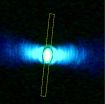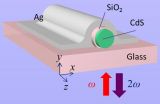(Press-News.org) The race to make computer components smaller and faster and use less power is pushing the limits of the properties of electrons in a material. Photonic systems could eventually replace electronic ones, but the fundamentals of computation, mixing two inputs into a single output, currently require too much space and power when done with light.
Researchers at the University of Pennsylvania have engineered a nanowire system that could pave the way for this ability, combining two light waves to produce a third with a different frequency and using an optical cavity to amplify the intensity of the output to a usable level.
The study was led by Ritesh Agarwal, professor of materials science and engineering in Penn's School of Engineering and Applied Science, and Ming-Liang Ren, a post-doctoral researcher in his lab. Other members of the Agarwal lab, Wenjing Liu, Carlos O. Aspetti and Liaoxin Sun, contributed to the study.
It was published in Nature Communications.
Current computer systems represent bits of information -- the 1's and 0's of binary code -- with electricity. Circuit elements, such as transistors, operate on these electric signals, producing outputs that are dependent on their inputs.
"Mixing two input signals to get a new output is the basis of computation," Agarwal said. "It's easy to do with electric signals, but it's not easy to do with light, as light waves don't normally interact with one another."
The difficulty inherent in "mixing" light may seem counterintuitive, given the gamut of colors on TV or computer screen that are produced solely by combinations of red, green and blue pixels. The yellows, oranges and purples those displays make, however, are a trick of perception, not of physics. Red and blue light are simply experienced simultaneously, rather than combined into a single purple wavelength.
So-called "nonlinear" materials are capable of this kind of mixing, but even the best candidates in this category are not yet viable for computational applications due to high power and large volume constraints.
"A nonlinear material, such a cadmium sulfide, can change the frequency, and thus the color, of light that passes through it," Ren said, "but you need a powerful laser, and, even so, the material needs to be a many micrometers and even up to millimeters thick. That doesn't work for a computer chip."
To reduce the volume of the material and the power of the light needed to do useful signal mixing, the researchers needed a way to amplify the intensity of a light wave as it passed through a cadmium sulfide nanowire.
The researchers achieved this through a clever bit of optical engineering: partially wrapping the nanowire in a silver shell that acts like an echo chamber. Agarwal's group had employed a similar design before in an effort to create photonic devices that could switch on and off very rapidly. This quality relied on a phenomenon known as surface plasmon resonance, but, by changing the polarization of the light as it entered the nanowire, the researchers were able to better confine it to the frequency-altering, nonlinear part of the device: the nanowire core.
"By engineering the structure so that light is mostly contained within the cadmium sulfide rather than at the interface between it and the silver shell, we can maximize the intensity while generating the second harmonic," Ren said.
Like a second harmonic played on a guitar string, this meant doubling the frequency of the light wave. Information in a photonic computer system could be encoded in a wave's frequency, or the number of oscillations it makes in a second. Being able to manipulate that quality in one wave with another allows for the fundamentals of computer logic.
"We want to show we can sum two frequencies of light,"Agarwal said, "so we simplified the experiment. By taking one frequency and adding it to itself, you get double the frequency in the end. Ultimately, we want to be able to tune the light to whatever frequency is needed, which can be done by altering the size of the nanowire and the shell."
Most important, however, was that this frequency mixing was possible on the nanoscale with very high efficiency. The researchers' optical cavity was able to increase the output wave's intensity by more than a thousand times.
"The frequency-changing efficiency of cadmium sulfide is intrinsic to the material, but it depends on the volume of the material the wave passes through," Agarwal said. "By adding the silver shell, we can significantly decrease the volume needed to get a usable signal and push the device size into the nanoscale."
INFORMATION:
The research was supported by the U.S. Army Research Office, National Institutes of Health and Air Force Office of Scientific Research.
Rice University scientists have invented a novel cathode that may make cheap, flexible dye-sensitized solar cells practical.
The Rice lab of materials scientist Jun Lou created the new cathode, one of the two electrodes in batteries, from nanotubes that are seamlessly bonded to graphene and replaces the expensive and brittle platinum-based materials often used in earlier versions.
The discovery was reported online in the Royal Society of Chemistry's Journal of Materials Chemistry A.
Dye-sensitized solar cells have been in development since 1988 and have been the subject ...
Scientists using a microbe that occurs naturally in eastern cottonwood trees have boosted the ability of two other plants - willow and lawn grass - to withstand the withering effects of the nasty industrial pollutant phenanthrene and take up 25 to 40 percent more of the pollutant than untreated plants.
The approach could avoid the regulatory hurdles imposed on transgenic plants - plants with genes inserted from or exchanged with other plant or animal species - that have shown promise in phytoremediation, the process of using plants to remove toxins from contaminated sites, ...
More than a decade ago, researchers from Brigham and Women's Hospital (BWH) demonstrated that a high dose statin, which lowered cholesterol further than a regular dose statin, provided better clinical outcomes. But questions remained about whether further reducing cholesterol would be even more effective in reducing cardiovascular-related events.
Now, results of the highly anticipated IMProved Reduction of Outcomes: Vytorin Efficacy International Trial (IMPROVE-IT), co-led by researchers at BWH and Duke Medicine, indicate that adding a second drug, ezetimibe, that blocks ...
WCS, NASA, And other conservation and remote sensing agencies, universities and NGOs focus on top 10 conservation questions for satellite technology
Remote sensing has and can continue to play a critical role in conserving Earth's biological diversity
Protected area management is a key use of remote sensing data
Newly formed Conservation Remote Sensing Network to apply remote sensing data to conservation challenges
NEW YORK (November 17, 2014)--Scientists from the WCS (Wildlife Conservation Society), NASA, and other organizations have partnered to focus global attention ...
Harvard Stem Cell Institute (HSCI) researchers, representing five Harvard departments and affiliated institutions as well as the Massachusetts Institute of Technology (MIT), have demonstrated that adult cells, reprogrammed into another cell type in a living animal, can remain functional over a long period.
The work by Joe Zhou, an associate professor in Harvard's Department of Stem Cell and Regenerative Biology, and his collaborators is an important advance in the effort to develop cell-based therapies for tissue repair, and specifically in the effort to develop improved ...
HOUSTON - (Nov. 17, 2014) - Offering small financial incentives doubles smoking cessation rates among socioeconomically disadvantaged smokers, according to research from The University of Texas Health Science Center at Houston (UTHealth). The findings were published last week in the American Journal of Public Health.
Tobacco use is the leading cause of preventable death in the United States, according to the Centers for Disease Control and Prevention. Thanks to public health efforts, smoking rates have declined to 18 percent among American adults. However, nearly 30 percent ...
If your surname reveals that you descended from the "in" crowd in the England of 1066--the Norman Conquerors--then even now you are more likely than the average Brit to be upper class. To a surprising degree, the social status of your ancestors many generations in the past still exerts an influence on your life chances, say Gregory Clark of the University of California, Davis, in the US and Neil Cummins of the London School of Economics in the UK. They used the Oxbridge attendance of people with rare English surnames (last names) to track social mobility from 1170 to 2012. ...
(NEW YORK - November 17) Brief usage of the painkiller oxycodone may impair behavioral flexibility even after that use ends, suggesting impaired decision-making as an enduring consequence of exposure, according to a study conducted at the Icahn School of Medicine at Mount Sinai and published November 17 in the journal Learning and Memory.
The Mount Sinai study investigated behavioral flexibility, the ability to select new responses when otherwise familiar circumstances change. In people and rodents exposed to drugs of addiction, repeated actions can become automated ...
Raptors, or birds of prey, some of which are endangered species, typically live in environments that provide natural land cover, such as forests and grasslands. Protecting endangered raptor species helps maintain food chain balance and prevents overpopulation of common raptor prey, such as snakes and rodents. As more businesses are built on the edges of urban areas, land where raptors once lived becomes industrialized, which raises concerns about the consequences of habitat destruction on raptor populations. Now, University of Missouri researchers have found that businesses ...
ANN ARBOR -- Researchers at the University of Michigan have discovered how a previously unknown hormone serves as a messenger from fat cells to the liver and are investigating the potential of developing a new treatment for metabolic disorders.
Jiandie Lin of the Life Sciences Institute described how in mice the hormone, NRG4, is secreted by so-called brown fat cells and communicates with the liver to regulate the conversion of sugar into fat. Mice without NRG4 became obese and developed hallmarks of type 2 diabetes and fatty liver disease. When scientists genetically ...






